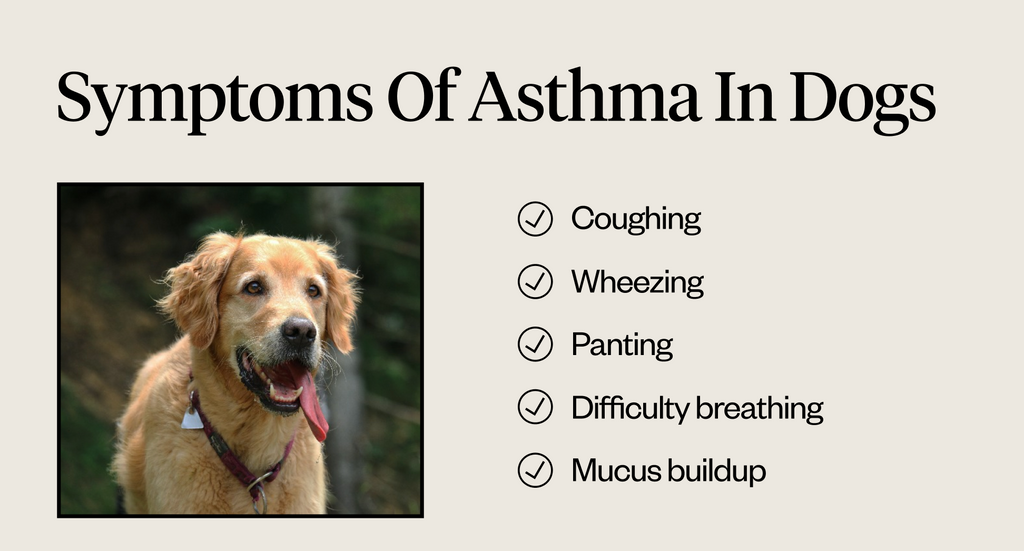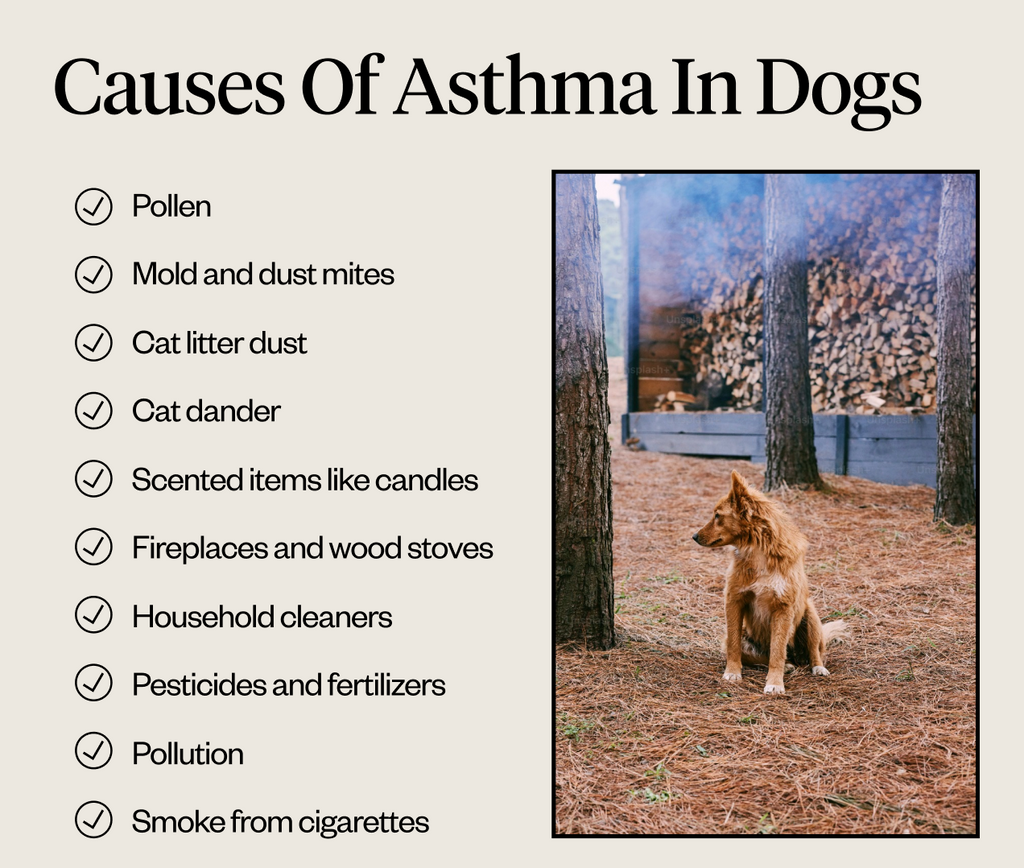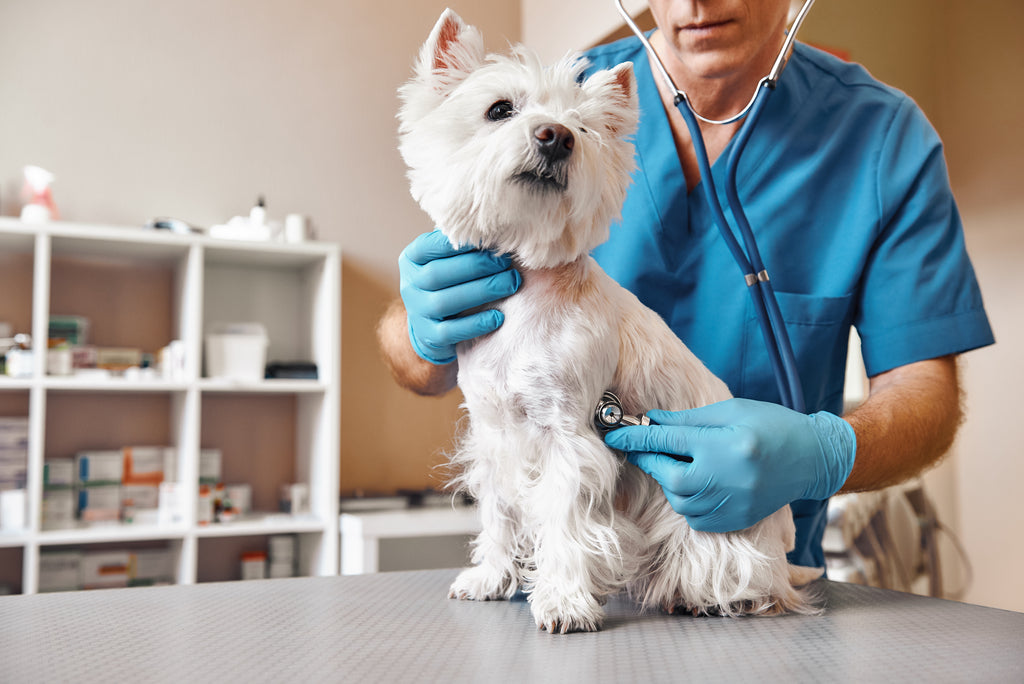11 Min Read
Can Dogs Have Asthma?
Key takeaway
Dogs suffering from asthma exhibit symptoms like humans, such as wheezing and coughing. Asthma in dogs is primarily triggered by environmental allergies, and while there are specific treatments like nebulizers and medications, prevention is crucial.

Why pet owners are switching to online vet care with Dutch
-
Prescriptions delivered free to you
-
Fast access to Licensed Vets over video
-
Unlimited video visits and follow-ups
As pet parents, we often compare our furry friends’ health concerns to our own. Asthma, a respiratory condition in humans, manifests with symptoms like wheezing, coughing, and breathlessness. But can dogs have asthma?
Unfortunately, asthma in dogs is possible, though it’s much more common in cats.[1] Dog asthma is an allergic disease triggered by allergic reactions, which can cause inflammation in the airways and associated breathing issues.[1] 15% of dogs with allergies also develop inflammation inside the nose (rhinitis) and asthma.[2]
Recognizing and understanding dog asthma can be crucial for their health and quality of life. Keep reading to learn more about asthma in dogs, its symptoms, causes, and treatment options.
Symptoms

Can dogs get asthma? Much like humans, they can experience asthma symptoms associated with allergies. Many will experience difficulty breathing, wheezing, and coughing. In more severe cases, the dog might show signs of increased effort to breathe and blue gums due to a lack of oxygen.[1]
Common symptoms of a dog asthma attack include:
- Coughing
- Wheezing
- Panting
- Difficulty breathing
- Mucus buildup
- Panic
Dogs experiencing an asthma attack may experience panic. This anxiety-driven response can manifest as an inability to calm down and restlessness. Additionally, they may try to hide or seek comfort from their pet parents. Understanding these signs can help pet parents provide immediate reassurance and calming measures to soothe their distressed canine companions.
Causes

Asthma attacks in dogs are caused by allergies. When your dog inhales an allergen, it can irritate their airways, causing inflammation and the associated asthma symptoms.[1] Common allergens in and around your household that might trigger a dog asthma attack include the following:
- Pollen
- Mold and dust mites
- Cat litter dust
- Cat dander
- Air fresheners, perfumes, or scented candles
- Fireplaces and wood stoves
- Household cleaners
- Pesticides and fertilizers
- Pollution
- Smoke from cigarettes, pipes, cigars, or e-cigarettes
Diagnosis
Unfortunately, asthma in dogs can be difficult to diagnose because the symptoms only occur when your dog is having an asthma attack. If you notice any asthma symptoms, you should take them to the vet immediately so your vet can observe them.[1]
At your dog’s vet appointment, the diagnostic process will begin with a thorough history of their health and noticeable symptoms to provide insight into the onset, duration, and frequency of symptoms to help differentiate asthma from other conditions.
Your vet will also perform a physical exam to check for signs of respiratory distress, such as listening to their lungs for signs of wheezing, and assess their overall physical condition.
One of the main diagnostic tests used to diagnose asthma in dogs is chest X-rays, also known as radiographs. X-rays of the chest can help visualize abnormalities in the lungs and airways and may show patterns consistent with inflammation or changes associated with asthma.[1]
Unfortunately, if your dog isn’t actively having an asthma attack, an X-ray may come back as normal.[1] Therefore, diagnosing asthma in dogs can generally be challenging for vets because when they’re not having an asthma attack, they can’t see the symptoms for themselves. If you can’t get to the vet during an asthma attack, take a video of your dog to share with your vet.[1]
While asthma is a possibility for why your dog is experiencing various breathing problems, coughing, wheezing, and so forth, asthma symptoms in dogs can often resemble those of other illnesses, including potentially life-threatening conditions like heartworm disease.[1]
Your vet will want to see your dog as soon as possible to rule out other possible causes of these symptoms, like heartworm disease, bronchitis, and tracheal collapse.
Treatment

Treating dog asthma can be difficult because the main goal is to try to prevent the asthma attack. However, pet parents should know what to do when their dog is actively having an attack.
If your dog is actively having an asthma attack, it’s considered a veterinary emergency.[1] Your vet may hospitalize your dog and use oxygen to facilitate easier breathing.[1] Beyond assisting with breathing, intravenous (IV) catheters might be inserted to directly administer drugs or provide fluid therapy, especially if the pet shows signs of dehydration or hasn’t been able to eat or drink.[1]
The medications delivered through IVs can range from bronchodilators to antihistamines and steroids to combat the inflammation of the airways. In cases where infections are present, IV antibiotics may also be used.
For dogs with mild asthma symptoms, foundational treatments, such as allergy medicine for dogs, steroids, and bronchodilators, remain the same but can be administered orally or via a nebulizer instead.[1]This device converts the liquid form of a medication into a mist that dogs can inhale.
Nebulizers offer an immediate therapeutic advantage by delivering the drug directly into the lungs while humidifying the air, which can loosen mucus in the lungs, affecting your dog’s ability to breathe.[1]
Nebulizer treatments can be performed at a vet’s office or at home with the right equipment. However, collaboration with your vet is crucial to determine if nebulization suits your dog and get guidance on training your pet to use the device.[1] If you have difficulty getting your dog to use the device, your vet will prescribe the oral version of these medications to help reduce and eliminate asthma symptoms.
Keep in mind that, as with many conditions, prevention is more effective than treatment. When it comes to dog asthma, pinpointing and avoiding triggers that can cause allergic reactions is crucial. Vets can conduct allergy testing to identify specific allergens that may be affecting your dog. Then, with this information, certain practices can significantly reduce exposure.
The key to avoiding an asthma attack is to avoid triggering your dog’s allergies. Here are a few tips to help reduce your dog’s exposure to allergens inside and outside the home:
- Indoor air quality: Invest in a high-quality air purifier with a HEPA filter for your home.[1] This can capture airborne allergens like pollen, dust mites, and mold spores, helping to keep the indoor air clean.
- Smoke-free environment: Avoid smoking or vaping inside your home or near your dog.[1] Tobacco smoke can irritate the lungs and trigger asthma symptoms.
- Regular cleaning: Vacuum your home frequently using a vacuum cleaner equipped with a HEPA filter. Additionally, clean and dust surfaces regularly to reduce the accumulation of allergens like dust.
- Limit the use of fireplace: Burning wood can release smoke and other particles into the air, which can be potential triggers. If you have a fireplace, avoid using it near your dog.[1]
- Choose pet-friendly cleaning products: Choose natural or pet-friendly cleaning products that don’t contain chemicals that can irritate sensitive dogs.
- Bathing and grooming: Regularly bathe and groom your dog to remove allergens from their coat. Always use dog-appropriate shampoo to avoid skin irritations.
- Outdoor precautions: During high pollen count days or specific seasons when your dog’s allergens are prevalent, limit outdoor activities or choose times when the allergen count is lower, typically early mornings or late evenings.
- Pet bedding: Wash your dog’s bedding frequently in hot water and use hypoallergenic detergents to remove dust mites and other potential allergens.[1]
- Choose fragrance-free: Avoid using scented candles, air fresheners, or incense inside your home. These fragrances and smoke can irritate your dog’s respiratory system.
Managing asthma in dogs requires a multi-pronged approach to address immediate concerns, institute ongoing treatments, and prevent exposure to allergens that trigger dog asthma attacks. By working closely with your veterinarian, you can ensure your dog’s environment is as asthma-free as possible.
FAQS
What does asthma in dogs sound like?
Asthma in dogs leads to specific audible signs due to the inflammation and narrowing of the airways. When a dog is experiencing an asthma attack, one of the most noticeable signs is wheezing. Wheezing is a high-pitched sound that usually occurs when the dog is trying to exhale, though it can be heard during inhalation in severe cases. This sound occurs as a result of air trying to pass through narrowed airways.
Apart from wheezing, dogs with asthma might also produce a persistent, dry cough. The cough may be frequent and harsh, sounding almost like they’re trying to clear something from their throat. Sometimes, the cough can be mistaken for gagging or retching, especially if the dog is trying to catch its breath.
Because coughing and wheezing are common symptoms of other dog ailments, you should seek veterinary intervention as soon as possible to rule out potentially life-threatening illnesses and get a diagnosis and treatment to make your dog more comfortable.
What triggers dog asthma?
Asthma in dogs, much like in humans, is often triggered by specific allergens in the environment. Common culprits behind these episodes include pollen, mold, cigarette smoke, and household cleaning products. Recognizing these triggers is crucial.
Once you and your vet pinpoint the specific cause of your dog's asthma attacks, the most effective preventive measure is to eliminate or significantly reduce that allergen’s presence in your home.
By actively minimizing your dog’s exposure to these irritants, you can make their living environment safer while reducing the likelihood of asthma attacks.
Can you give a dog Benadryl for asthma?
Benadryl, also known by its generic name diphenhydramine, is an antihistamine commonly used for allergic reactions in humans and animals. For dogs, it’s administered to address symptoms like itchy skin, swelling, and rashes. While Benadryl can help reduce allergic reactions, asthma is a complex condition involving inflammation and the constriction of the airways, which may not always be directly related to the release of histamines. Therefore, it may not be effective.
If you believe your dog is having an asthma attack, it’s crucial to consult with your vet before administering any medication, including Benadryl. While Benadryl might help in some cases where allergies trigger asthma symptoms, it may not be an effective treatment. Plus, you’ll need to know your pet's exact dosing instructions.
Your veterinarian can provide guidance on the appropriate treatments and dosages tailored to your dog’s specific needs.

Final Notes
So, can dogs have asthma? Like humans, dogs can experience asthma with symptoms ranging from mild wheezing to severe respiratory distress. Proper diagnosis and understanding of specific triggers is crucial. While treatments are available, it’s essential to work closely with a veterinarian to ensure optimal care and effective treatment plans. In most cases, the treatment will be to treat your dog’s allergies to reduce asthma symptoms.
Talk to a Dutch vet today to discuss your dog’s symptoms from the comfort of your home. Our licensed vets can provide advice, diagnosis, and treatments without the stress of a clinic visit. Try Dutch today.
Share
References
-
Wooten, Sarah. “Can Dogs Have Asthma?” PetMD, 25 Apr. 2019, www.petmd.com/dog/general-health/can-dogs-have-asthma.
-
White, Stephen D., and Karen A. Moriello. “Allergies in Dogs - Dog Owners.” Merck Veterinary Manual, 22 Aug. 2023, www.merckvetmanual.com/dog-owners/skin-disorders-of-dogs/allergies-in-dogs.



